Picture yourself on the open road, the wind rushing past, when suddenly your motorcycle stutters and struggles to shift gears. It's a frustrating moment that can leave you wondering what went wrong. Tackling gearbox issues requires a systematic approach to avoid costly repairs and guarantee your ride remains smooth. From understanding common symptoms to knowing when to consult a mechanic, there are essential tips that can guide you through these challenges. Ready to discover how to keep your motorcycle's gearbox in top shape?
Key Takeaways
- Regularly inspect gearbox components for wear and damage to catch issues early before they escalate.
- Ensure proper lubrication and fluid levels to prevent friction and noise within the gearbox.
- Address any unusual noises immediately, as they may indicate serious underlying problems.
- Check and adjust the clutch system and gear linkage for proper alignment to improve shifting performance.
Understanding Ducati Gearbox Design
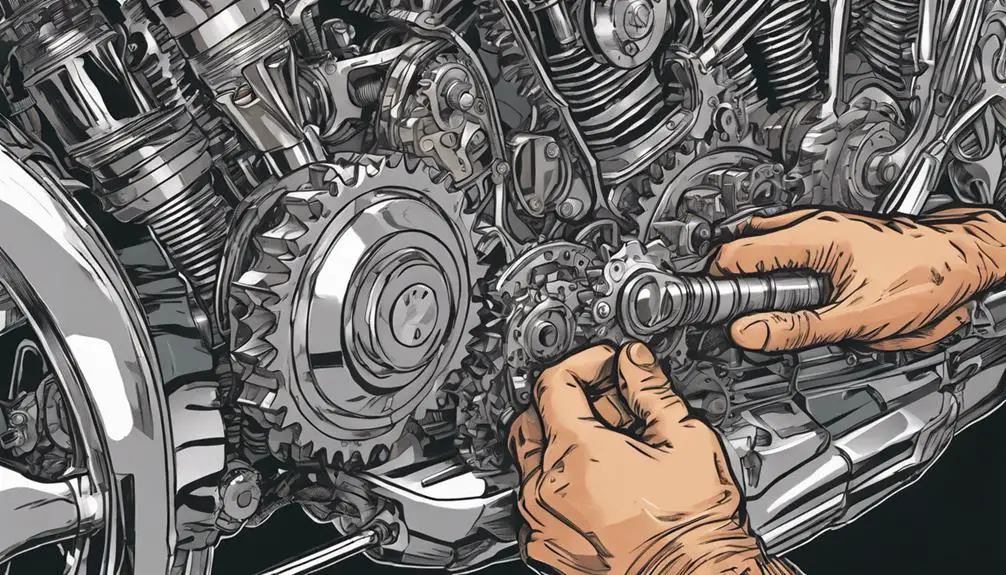
When you plunge into Ducati's gearbox design, you'll discover a blend of engineering precision and innovative technology that enhances your riding experience. Ducati's commitment to performance shines through in every aspect of their gearbox, ensuring you feel connected to the road beneath you. Each shift is smooth and decisive, allowing you to release your bike's full potential with confidence.
The design features a unique gear selection mechanism, which reduces friction and enhances efficiency. You'll appreciate how this allows for quicker gear changes, giving you the freedom to accelerate with ease. The lightweight materials used in the construction further contribute to the bike's agility, making you feel like you're an extension of the machine.
Ducati also incorporates advanced lubrication systems that minimize wear and tear, prolonging the lifespan of the gearbox. This means fewer interruptions in your journey towards liberation on two wheels. You can focus on the thrill of the ride, knowing that the engineering behind your bike supports your adventurous spirit.
Embrace the open road, and let Ducati's gearbox design elevate your riding experience to exhilarating new heights.
Common Symptoms of Gearbox Issues
You might notice several telltale signs that indicate your motorcycle's gearbox is experiencing issues. One of the most common symptoms is unusual noises. If you hear grinding, clunking, or whining sounds when shifting gears, it's a clear signal that something's off.
You might also feel a lack of responsiveness when you twist the throttle or attempt to shift. If your bike hesitates or struggles to change gears, it's time to pay attention.
Another significant symptom is a slipping clutch. If your engine revs up without a corresponding increase in speed, that could mean your gearbox isn't engaging properly. Shifting can also become sticky or difficult, making it harder to find the right gear.
Fluid leaks are another concern; if you spot oil pooling under your bike, it's likely your gearbox is leaking.
Finally, an illuminated warning light on your dashboard shouldn't be ignored; it often signals a problem within the transmission system.
Stay tuned into these signs, and you'll be well on your way to liberating your ride from gearbox troubles!
Identifying Transmission Problems
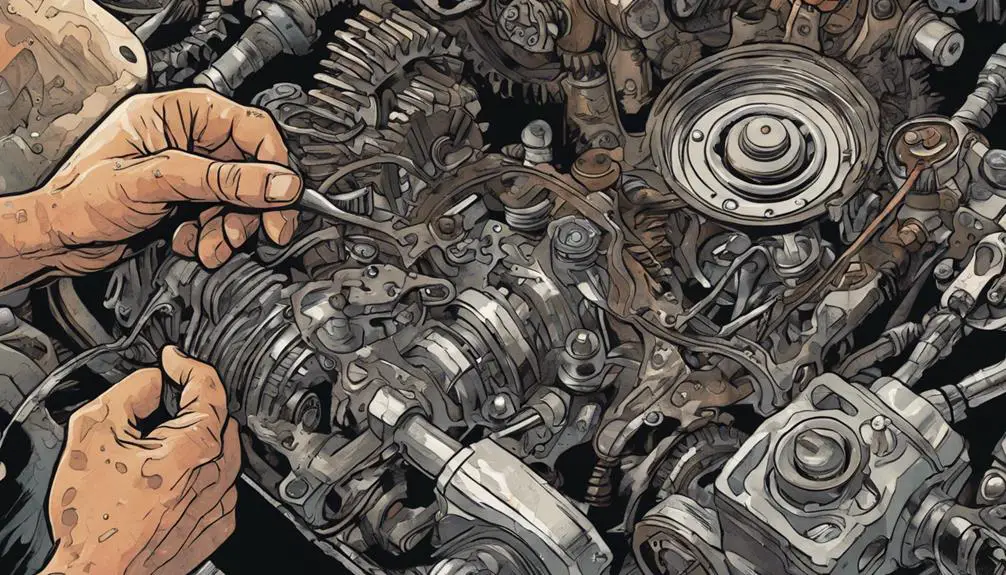
Identifying transmission problems requires careful observation of your motorcycle's performance and responsiveness. You need to be in tune with how your ride feels, listening for any unusual sounds or noticing any shifts in behavior. If something feels off, don't ignore it. Pay attention to these signs:
- Unusual grinding noises: A harsh, metallic sound could indicate worn gears or insufficient lubrication.
- Slipping gears: If your bike unexpectedly changes gears while you're riding, it's a clear sign that something's amiss.
Importance of Regular Maintenance
Regular maintenance is essential for keeping your motorcycle's gearbox in top shape.
By scheduling inspections and addressing issues early, you can prevent costly repairs down the line.
Staying proactive not only extends your bike's lifespan but also enhances your riding experience.
Preventive Maintenance Benefits
Maintaining your motorcycle consistently can prevent costly gearbox issues down the road. Regular preventive maintenance not only keeps your ride smooth but also enhances your freedom on the open road. When you invest time in upkeep, you're ensuring that your bike stays reliable, allowing you to explore without worrying about unexpected breakdowns.
Consider the benefits of preventive maintenance:
- Enhanced Performance: A well-maintained gearbox shifts smoothly, giving you that exhilarating feeling of power and control as you accelerate.
- Extended Lifespan: Keeping an eye on your bike's components means you can catch minor issues before they become major problems, preserving your investment.
Scheduled Inspection Importance
Scheduled inspections are essential for catching potential gearbox issues before they escalate, ensuring your motorcycle runs smoothly and reliably on every ride. By committing to regular checks, you're not just preserving your bike; you're also embracing the freedom that comes with knowing your ride is in top condition.
During these inspections, you'll want to focus on fluid levels, wear and tear, and any unusual noises that could signal trouble. Addressing these problems early means you won't face unexpected breakdowns that can shackle you to the side of the road. You value your independence, and a well-maintained gearbox helps you maintain that.
Furthermore, regular inspections can save you money in the long run. Fixing minor issues is far cheaper than repairing or replacing a severely damaged gearbox. You'll be able to ride with confidence, knowing you're taking proactive steps to protect your investment.
Inspecting Gearbox Components
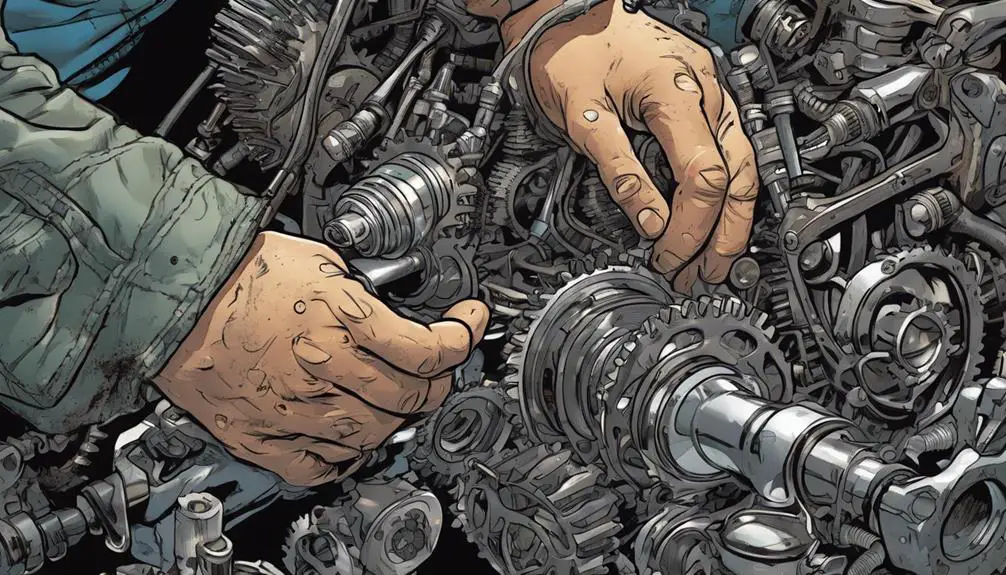
Inspect gearbox components frequently to catch any signs of wear or damage early on. A smooth ride depends on the health of your gearbox, and a little attention can go a long way in maintaining that sense of freedom.
Take a close look at the following parts during your inspection:
- Gears: Check for chipped teeth or signs of pitting. Any irregularities can lead to shifting issues.
- Bearings: Listen for strange noises. Worn bearings can create a rough ride and compromise your control.
Oil Type and Change Intervals
Choosing the right oil and sticking to change intervals can greatly impact your gearbox's performance and longevity. You want to release the full potential of your ride, and that starts with selecting the correct oil. Consult your motorcycle's manual to determine whether you need synthetic, semi-synthetic, or conventional oil. Each type offers varying degrees of protection, so choose wisely based on your riding style and conditions.
Next, don't underestimate the importance of regular oil changes. Engine oil breaks down over time, losing its protective properties and becoming less effective. Depending on your bike and riding habits, change the oil every 3,000 to 6,000 miles. If you ride aggressively or in harsh conditions, you might want to change it more frequently.
Keep an eye on the oil level and look for signs of contamination. You're not just maintaining your gearbox; you're ensuring that the freedom of the open road remains yours. By following these guidelines, you can maximize your motorcycle's performance and enjoy a smoother, more liberating ride for years to come.
Embrace the power of preventive care and ride with confidence!
Troubleshooting Shifting Difficulties
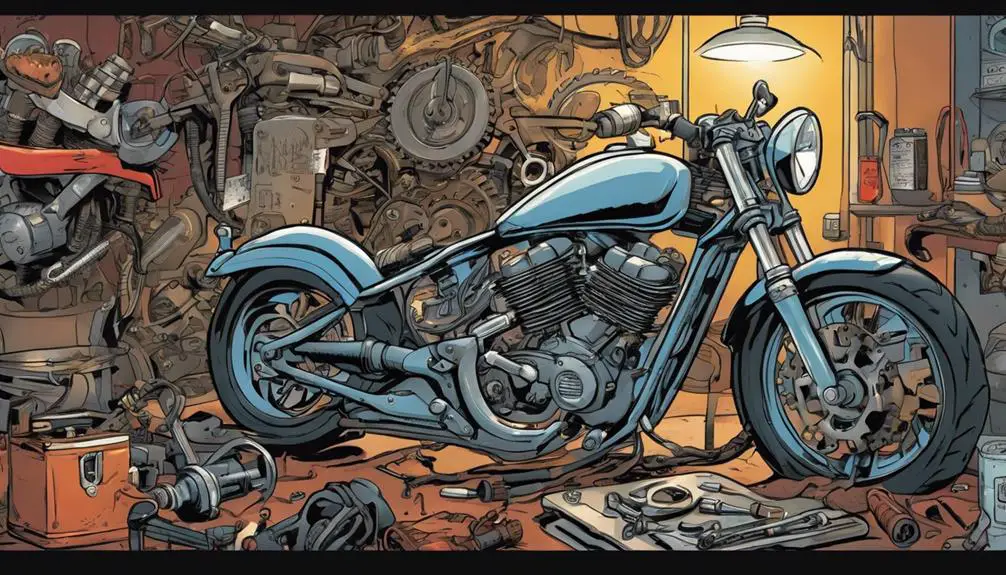
If you're experiencing shifting difficulties, there are several key factors to contemplate that could help you get back on the road smoothly.
Start by checking your clutch system; a poorly adjusted or worn-out clutch can make shifting a challenge.
Next, examine your gear linkage. If it's bent or misaligned, it can hinder your ability to shift smoothly.
Finally, consider the state of your transmission fluid. If it's dirty or low, it can affect performance greatly.
Here are three things to inspect:
- Clutch Cable: Verify it's properly adjusted and lubricated for effortless operation.
- Gear Lever: Check for any play or looseness, which can impact shifting precision.
Addressing these factors can free you from the hassle of shifting issues and allow you to fully embrace the freedom of the open road.
Remember, a little maintenance goes a long way in keeping your ride smooth and exhilarating.
Don't let shifting difficulties hold you back—take action and reclaim your adventure!
Addressing Noise and Vibration
When you notice unusual noise or vibration in your motorcycle, it's essential to identify the source right away.
Check for any misalignment in the gearbox components and verify your gear lubrication is up to par.
Addressing these issues promptly can prevent further damage and guarantee a smoother ride.
Identify Noise Sources
Listen closely to your motorcycle; unusual noises can often reveal underlying gearbox issues that need immediate attention. Ignoring these sounds can lead to bigger problems down the road, so you must tune in.
Here are some common noises to watch out for:
- Grinding: A rough, metallic sound that suggests you've got worn gears or insufficient lubrication.
- Clunking: A heavy, jarring noise indicating that components aren't engaging properly, often due to misaligned parts.
Check for Misalignment
Checking for misalignment is vital, as even slight deviations can lead to increased noise and vibration in your motorcycle's gearbox. These issues can rob you of the freedom you crave when riding.
To tackle this, start by inspecting the alignment of the gearbox and the engine. Verify all mounting bolts are tight and free from corrosion. A loose bolt can throw everything off balance, causing vibrations that can shake you to your core.
Next, examine the drive chain and sprockets. They need to be in line; misalignment here can create a ruckus that disrupts your ride. Adjust the chain tension, and make certain it sits properly on the sprockets. If you're still experiencing noise, check the output shaft and input shaft for any wear or damage.
Use a straightedge to verify everything is aligned. It might take some time, but this step is imperative for a smooth ride.
Inspect Gear Lubrication
Proper gear lubrication plays a significant role in reducing noise and vibration, complementing your efforts in guaranteeing alignment is spot on.
When your motorcycle's gearbox is well-lubricated, it not only enhances performance but also prolongs the life of your bike.
Here's what you need to check:
- Fluid Level: Guarantee the lubrication fluid is at the right level; low fluid can lead to increased friction and noise.
- Fluid Condition: Inspect the fluid for contaminants or discoloration. Dirty or burnt fluid can create unwanted vibrations and damage gears.
Repair Vs. Replacement Decisions
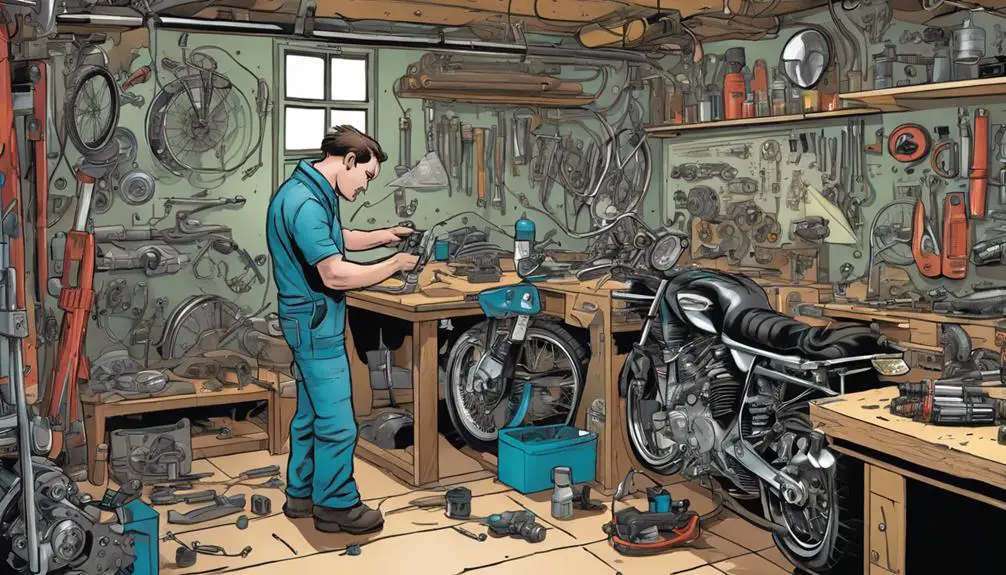
When faced with gearbox issues, you'll need to weigh whether repairing the existing components or replacing them entirely makes the most sense for your motorcycle's performance and your budget.
Think about the extent of the damage. If it's minor, like worn bearings or seals, a repair might be all you need to get back on the road. Repairs can often be less costly and allow you to maintain your bike's original character.
However, if you're dealing with a major failure, like a cracked casing or irreparable gears, replacement could be the more practical option. Investing in new components can improve your ride's reliability and performance, giving you peace of mind on long journeys.
Consider your long-term goals, too. If you plan to keep your bike for years, investing in quality replacements might pay off. On the other hand, if you're looking to sell soon, a repair could keep costs down while still maintaining functionality.
Ultimately, trust your instincts. Assess the condition and your riding style, and choose the path that aligns with your freedom on the road. Your motorcycle deserves the best, whether through repair or replacement.
Seeking Professional Help
If you find yourself unsure about the right course of action for your gearbox issues, seeking professional help can provide valuable insights and expertise. A trained mechanic can pinpoint the problem and offer solutions that keep your ride smooth and liberating. Don't hesitate to reach out when you need that extra hand; it's a smart move for both your bike and your peace of mind.
When you consult a professional, expect them to:
- Diagnose accurately: They'll assess the gearbox's condition and identify the root cause of the problem quickly.
- Suggest tailored solutions: Based on their expertise, they'll recommend repairs or replacements that fit your specific needs and riding style.
Frequently Asked Questions
How Can I Prevent Gearbox Issues in My Motorcycle?
To prevent gearbox issues in your motorcycle, you've got to stay proactive.
Regularly check your oil levels and change the oil as needed; clean oil keeps everything running smoothly.
Pay attention to unusual sounds or shifting difficulties—these signals shouldn't be ignored.
Also, maintain proper chain tension and alignment.
Finally, don't forget to ride responsibly; aggressive riding can put extra stress on your gearbox.
Keep your machine healthy, and it'll reward you with freedom!
What Tools Do I Need for Gearbox Inspection?
So, you think you can just waltz into a gearbox inspection without the right tools?
You'll need a socket set, a torque wrench, and some screwdrivers – not just any screwdrivers, but the ones that actually fit!
A feeler gauge will help with precision, and don't forget the flashlight to illuminate your path to freedom.
With these tools, you're not just checking a gearbox; you're liberating it from its mechanical chains!
Are Aftermarket Parts Reliable for Gearbox Repairs?
When considering aftermarket parts for gearbox repairs, you need to weigh reliability against cost.
While some aftermarket options can offer great performance and durability, others might fall short.
Research the manufacturer and read reviews to verify you're choosing a reputable source.
Trust your instincts, and don't hesitate to ask fellow riders for their experiences.
Quality aftermarket parts can liberate you from costly repairs down the road, so choose wisely and ride confidently.
How Often Should I Check My Gearbox Alignment?
You should check your gearbox alignment regularly, preferably every few rides or after any significant impact.
Staying proactive helps guarantee peak performance and prevents costly repairs down the line.
If you feel any unusual vibrations or hear strange noises, it's a sign to inspect it sooner.
Trust your instincts—maintaining your ride's alignment not only enhances safety but also supports your freedom on the road.
Keep that spirit of liberation alive!
Can I Fix Gearbox Problems Without Professional Help?
You might wonder if you can tackle gearbox problems on your own. Picture yourself in the garage, tools in hand, ready to plunge into the mechanics.
Sure, you can attempt some fixes, like adjusting cables or changing fluids, but be cautious. Without proper knowledge, you risk making things worse.
Empower yourself with research and practice, but don't hesitate to call a pro if you hit a wall. Your ride deserves the best!
Conclusion
In the world of motorcycle gearboxes, staying proactive is your best ally.
Think of regular maintenance as a shield, protecting your ride from future issues.
By tuning into the sounds and feels of your bike, you can catch problems before they escalate.
Whether you're troubleshooting or seeking expert help, remember that a well-cared-for gearbox is like a well-oiled machine—smooth and reliable.
So gear up, stay alert, and keep your motorcycle running at its best!